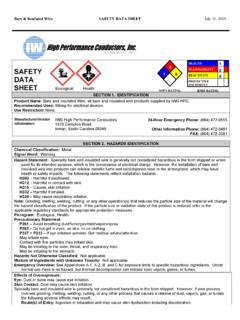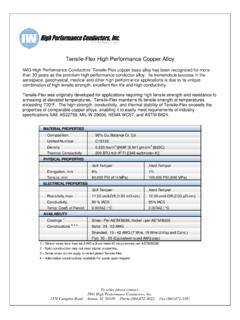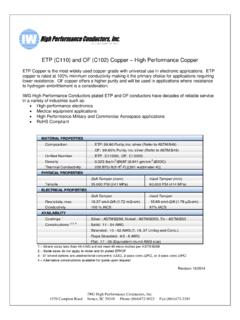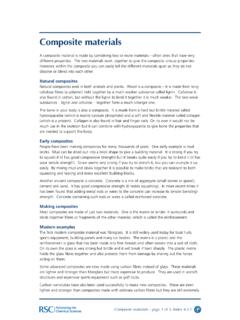Transcription of Lightweight Copper/Aluminum Composites – Next …
1 Lightweight Copper/Aluminum Composites next generation Conductors for the Aerospace Market Emilio I. Cerra VP Product Development & Engineering IWG High Performance Conductors Abstract Weight reduction is a never-ending challenge on an aircraft and the latest generation of fuel efficient airplanes has placed even more pressure on manufacturers to reduce weight. Unfortunately, in the realm of aerospace cables, there has been precious little improvement in weight reduction over the past decade, and what has occurred has been primarily due to insulation system improvements. The electrical conductors used in these cables have not changed significantly during that time. This paper will explore a new conductor construction that, utilizing both copper and aluminum strands, has the potential for reducing cable weight without significantly impacting resistance and, more importantly, without changing the methods with which said conductors are terminated.
2 1. Introduction Electrical conductors used in aerospace cables have remained virtually unchanged since the introduction of advanced alloys such as PD135 (Tensile-Flex ) and CS95 by the Hudson Wire Company more than thirty years ago. In more recent years, EC aluminum and copper clad aluminum (CCA) ropes have been used in power feeder applications at both Boeing and Airbus. These conductors, however, require special care during manufacture and termination in order to avoid potential electrical failures. The introductions of popular new airframes such as Boeing s 787 Dreamliner and Airbus s A350 and A380 that promise significantly lower fuel consumption and operating costs have placed enormous pressure on aerospace engineers to reduce weight in all areas of the aircraft. One such conductor solution nickel plated aluminum and/or nickel plated copper clad aluminum has the unfortunate tendency to form cracks in the nickel coating.
3 To date these voids have been managed via careful control of the manufacturing and assembly processes; nevertheless the potential for trouble exists. Approximately six years ago IWG High Performance Conductors Inc. embarked on a project to develop a conductor with significantly lower weight per thousand feet relative to an equivalent copper conductor . The project included the following targets: Weight savings of 10-20% Economical alterative to existing products Easy to install; capable of utilizing existing connector/crimp technologies Designed for manufacturability After examining several alternative constructions and materials, High Performance Conductors (HPC) settled on a composite configuration that utilized both copper and aluminum strands in the conductor . 2. composite Constructions composite constructions are used in the wire and cable industry when properties are desired that are not available in existing materials; for example, ACSR power cables that use a steel core for tensile strength and aluminum alloys for electrical conductivity and weight savings.
4 The composite conductors described in this article utilize a core made of aluminum strands surrounded by an outer layer of copper wires. Constructions typically contain 19 or 37 wires (or members, in the case of a rope). As a point of reference, the evaluation sample referenced elsewhere in this document was a 1/0 gauge rope, containing 37 members with 7 strands of 24 gauge each (37x7/24). aluminum and copper were not mixed in the members nor in the layers; the 19 member core was made of 1350 EC aluminum and the outer 18 members were made of nickel plated ETP copper . The copper strands were coated with nickel at the request of the OEM testing the cable; silver or tin coatings could also be used. Figure 1. 37 member composite copper & aluminum rope construction EC AluminumETP Copper19 wire constructions on the other hand, are made with 7 inner strands (or members) of aluminum and 12 outer strands of copper .
5 These geometric constraints drive the physical characteristics of the cables; therefore a 37 wire cable will contain more aluminum as a percentage of the total conductor ( ) than a 19 wire cable ( ). This same 37 wire conductor will weigh less and be lower in conductivity than a similar sized cable using 19 wires. An alternate construction that would reduce the weight variation between 19 and 37 wire conductors by using alternating strands of copper and aluminum was also considered but ultimately discarded. This construction would have been more uniform in composition ( and aluminum respectively in 19 wire and 37 wire constructions), but would have contained aluminum strands in the outer layer, requiring the use of special connectors. In order to simplify production and reduce costs, as well as avoid the surface quality issues known to occur with nickel plated aluminum and copper clad aluminum , it was decided to leave the aluminum conductors unplated.
6 However, since galvanic corrosion of the aluminum strands is a potential concern in a construction of this nature the copper wires are plated to inhibit any incipient corrosion. 3. Weight Savings The primary purpose of these constructions is weight reduction; Tables 1 and 2 show expected weight and direct current resistance (DCR) values for a representative sample of nickel plated cables and ropes in both conventional copper and Copper/Aluminum constructions. Table 1. composite Copper/Aluminum conductor Properties Size Construction Weight (lbs/kft) DCR ( /kft) 22 19 x 34 20 19 x 32 18 19 x 30 16 19 x 29 14 19 x 27 12 37 x 28 10 37 x 26 8 19 x 7 / 29 6 19 x 7 / 27 4 19 x 7 / 25 2 19 x 35 / 30 1 19 x 43 / 30 1/0 19 x 55 / 30 2/0 19 x 70 / 30 3/0 37 x 45 / 30 4/0 37 x 57 / 30 Generally speaking, a 19 wire composite construction will be 26% lighter than an equivalent copper conductor , with DCR 16% higher than the same.
7 A 37 wire composite construction will be 36% lighter but 24% higher in resistance than an equivalent copper conductor . Table 2 Conventional copper conductor Properties Size Construction Weight (lbs/kft) DCR ( /kft) 22 19 x 34 20 19 x 32 18 19 x 30 16 19 x 29 14 19 x 27 12 37 x 28 10 37 x 26 8 19 x 7 / 29 6 19 x 7 / 27 4 19 x 7 / 25 2 19 x 35 / 30 1 19 x 43 / 30 1/0 19 x 55 / 30 2/0 19 x 70 / 30 3/0 37 x 45 / 30 4/0 37 x 57 / 30 In applications where resistance is of primary importance and DCR values must be maintained, increasing overall conductor size by approximately 6% in 19 wire and 9% in 37 wire composite constructions will ensure that resistance be unchanged. These cables would still be 14% and 21% lighter than their equivalent 19 & 37 wire counterparts, although the size change would preclude one from using existing connectors during termination.
8 4. Evaluation Sample A 37 member, 1/0 gauge evaluation sample (37x7/24) was submitted to a top-tier aerospace cable manufacturer to be insulated and tested, then sent to an end user for further corrosion, crimp and thermal shock tests. The insulated conductor was tested at the OEM to Douglas specification DMS 2340. With the exception of flexure endurance, all conductor related tests, including bend radius, stiffness, tensile and elongation passed the test requirements. All other insulation related tests passed as well. Table 3 lists flexure endurance test results for both the Copper/Aluminum composite and a nickel plated copper standard. In the case of the composite rope, as would be expected, aluminum strands began failing in the core by the 500th cycle, with all strands broken (both aluminum and copper ) by the 2,875th cycle (see figures 2 & 3). In contrast, the 1/0 gauge nickel plated copper rope did not exhibit strand failures until the 5,000 cycle mark.
9 Since there is no industry standard for flexure endurance failure, it will be necessary for individual OEMs and organizations such as ASTM and SAE to determine appropriate failure levels for these conductors going forward. Figure 2. Flexure endurance after 1,258 cycles; most aluminum strands broken Figure 3. Flexure endurance after 2,500 cycles; all aluminum and some copper strands broken If, however, higher flex life or tensile strength is required, alternative materials such as aluminum alloy 5254 can be used that will significantly improve performance, albeit with a noticeable increase in resistance. 5. next Steps Additional tests will be needed to gauge the ability of other commonly used plating materials such as silver and tin in reducing or eliminating galvanic activity. It will also be useful to see if other types of aluminum alloys are more or less susceptible to corrosion. Additionally, crimpability testing must be performed, including Mil-T-7928 terminal lug pull tests under a variety of environmental and aging conditions, to confirm the absence of cold creep in the terminations of these cables.
10 Finally, other construction types and sizes should be tested; in particular 19 strand unilay conductors of the type commonly used in airframe interconnect cables. HPC has prepared several 19 strand unilay conductors, most recently a 22 gauge conductor using 7 strands of 5254 aluminum alloy in the core with 12 strands of tin plated ETP copper in the outer layer. These conductors needs to be insulated and tested in a similar fashion to the 1/0 gauge rope described in the preceding section. Figure 4. Cross-section of 19 strand composite unilay conductor , 22 gauge 6. Conclusions composite Copper/Aluminum conductors as presented in this document exhibit considerable promise for use in aerospace applications. The cables are Lightweight ; in some cases as much as a third lighter than their copper -only counterparts, while producing a manageable 15 to 25% increase in resistance. In those cases where resistance is critical, 15 to 20% weight savings can be achieved with a modest diameter size increase of 6 to 9%.







